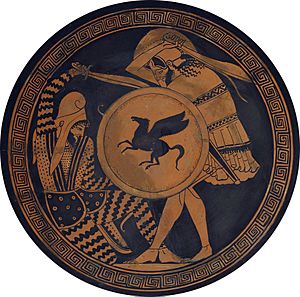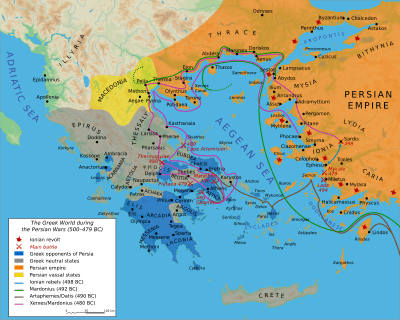Greco–Persian wars facts for kids
Quick facts for kids The Greco-Persian Wars |
|||||||||
|---|---|---|---|---|---|---|---|---|---|
 Greek hoplite and Persian warrior depicted fighting, on an ancient kylix, 5th century BC |
|||||||||
|
|||||||||
| Belligerents | |||||||||
| Greek city states including Athens and Sparta | Achaemenid Empire of Persia Macedon (initial phase) |
||||||||
| Commanders and leaders | |||||||||
| Miltiades Themistocles Leonidas I † Pausanias Cimon † Pericles |
Artaphernes Datis Artaphernes (son of Artaphernes) Xerxes I Mardonius † Hydarnes Artabazus Megabyzus |
||||||||

The Greco–Persian Wars were a series of wars fought between Classical Greece and Persia's Achaemenid Empire in the 5th century BC. The struggle lasted 50 years, from 499–449. Herodotus wrote a history of the war. Fifty years before the war started, Cyrus the Great had conquered the Greek colonies on the western coast of Asia Minor, an area the Greeks called Ionia. The Persians put a tyrant in charge of each city or polis. About 530 BC Cyrus died in battle.
Aristagoras, the Tyrant of Miletus was on an expedition to conquer the island of Naxos with Persian support, but that was a failure, Arisagoras encouraged Ionia to rebel against the Persians, leading them to the Ionian Revolt. Aristagoras got support from Athens and Eretria, and together they burnt the Persian regional capital city, Sardis. The Persian king, now Darius the Great, vowed revenge.
The Battle of Marathon
When the Ionian Revolt was finally over, then the Greeks and the Persians decided to place their next battle on the plain of Marathon. The Greeks won the Battle of Marathon, because of Miltiades' brilliant strategy. His strategy was to weaken the middle of the group of soldiers but leave the sides with many soldiers. Of course the Persians charged for the middle, that had less soldiers, then the sides of the Greek army swept in surrounding the Persians.
List of main events
- Ionian revolt 499–493 BC
- First invasion of Greece 492–490
- Second invasion of Greece 480–479
- Greek counter-attack 479–478
- Wars of the Delian League 477–449
Much of what is known of these wars comes from Herodotus.
Later wars
Although 449 BC saw the end of the wars started by the Ionian revolt, the two civilisations continued for more than a hundred years. The wars between Athens and Sparta allowed Persia to take back all she had lost in the Greco–Persian wars, until finally Alexander the Great put an end to the Achaemenid Empire. This is a brief summary of these later conflicts:
- First Peloponnesian War (Sparta vs Athens): 460–445 BC
- Second Peloponnesian War: 431–404
- Persians join Sparta in return for Ionia.
- Persian king Artaxerxes II demands return of Ionian cities.
- Humiliating peace treaty follows.
- Alexander the Great enters Asia and defeats the Persian king Darius III, ending his empire. 330 BC

